Cross-Border Mergers & Acquisitions: Strategic Motives Analysis
VerifiedAdded on 2023/06/08
|42
|12770
|359
Essay
AI Summary
This essay delves into the strategic motives behind cross-border mergers and acquisitions (CM&As) in the digital era, highlighting their significance in a globalized and rapidly evolving digital landscape. It examines the evolution of M&As, defines key concepts, and classifies different types of CM&As, such as horizontal, vertical, and conglomerate mergers. The study explores the driving forces behind CM&As, including accessing resources, technologies, expanding market reach, and increasing efficiency, while also acknowledging the challenges and obstacles, such as cultural differences and regulatory complexities. Furthermore, it raises research questions about the strategic motives and consequences of CM&As, aiming to provide insights and recommendations for businesses navigating the complexities of cross-border deals. The essay also includes a comprehensive literature review, providing a foundation for understanding the topic and its relevance in the modern business environment.
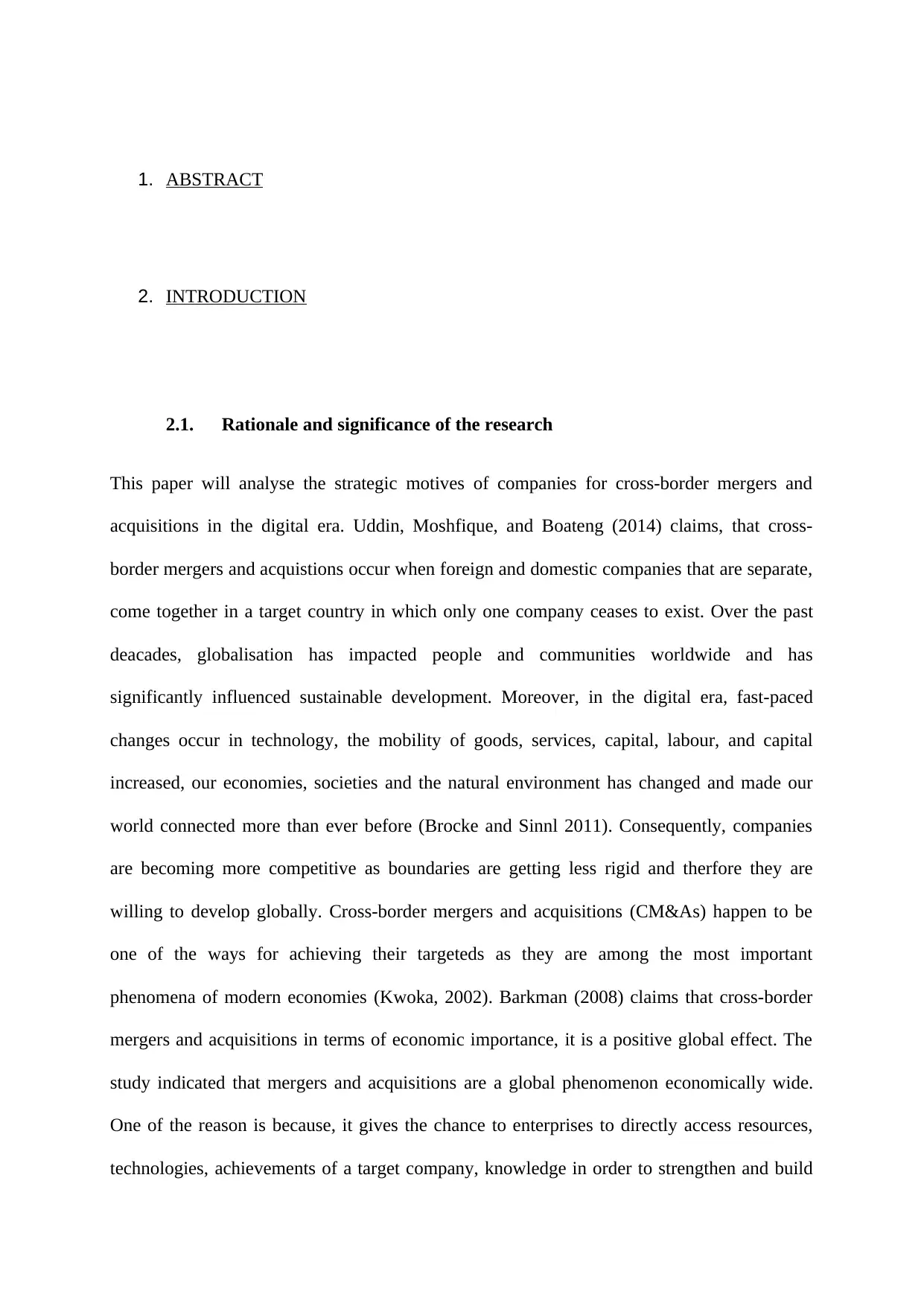
1. ABSTRACT
2. INTRODUCTION
2.1. Rationale and significance of the research
This paper will analyse the strategic motives of companies for cross-border mergers and
acquisitions in the digital era. Uddin, Moshfique, and Boateng (2014) claims, that cross-
border mergers and acquistions occur when foreign and domestic companies that are separate,
come together in a target country in which only one company ceases to exist. Over the past
deacades, globalisation has impacted people and communities worldwide and has
significantly influenced sustainable development. Moreover, in the digital era, fast-paced
changes occur in technology, the mobility of goods, services, capital, labour, and capital
increased, our economies, societies and the natural environment has changed and made our
world connected more than ever before (Brocke and Sinnl 2011). Consequently, companies
are becoming more competitive as boundaries are getting less rigid and therfore they are
willing to develop globally. Cross-border mergers and acquisitions (CM&As) happen to be
one of the ways for achieving their targeteds as they are among the most important
phenomena of modern economies (Kwoka, 2002). Barkman (2008) claims that cross-border
mergers and acquisitions in terms of economic importance, it is a positive global effect. The
study indicated that mergers and acquisitions are a global phenomenon economically wide.
One of the reason is because, it gives the chance to enterprises to directly access resources,
technologies, achievements of a target company, knowledge in order to strengthen and build
2. INTRODUCTION
2.1. Rationale and significance of the research
This paper will analyse the strategic motives of companies for cross-border mergers and
acquisitions in the digital era. Uddin, Moshfique, and Boateng (2014) claims, that cross-
border mergers and acquistions occur when foreign and domestic companies that are separate,
come together in a target country in which only one company ceases to exist. Over the past
deacades, globalisation has impacted people and communities worldwide and has
significantly influenced sustainable development. Moreover, in the digital era, fast-paced
changes occur in technology, the mobility of goods, services, capital, labour, and capital
increased, our economies, societies and the natural environment has changed and made our
world connected more than ever before (Brocke and Sinnl 2011). Consequently, companies
are becoming more competitive as boundaries are getting less rigid and therfore they are
willing to develop globally. Cross-border mergers and acquisitions (CM&As) happen to be
one of the ways for achieving their targeteds as they are among the most important
phenomena of modern economies (Kwoka, 2002). Barkman (2008) claims that cross-border
mergers and acquisitions in terms of economic importance, it is a positive global effect. The
study indicated that mergers and acquisitions are a global phenomenon economically wide.
One of the reason is because, it gives the chance to enterprises to directly access resources,
technologies, achievements of a target company, knowledge in order to strengthen and build
Paraphrase This Document
Need a fresh take? Get an instant paraphrase of this document with our AI Paraphraser
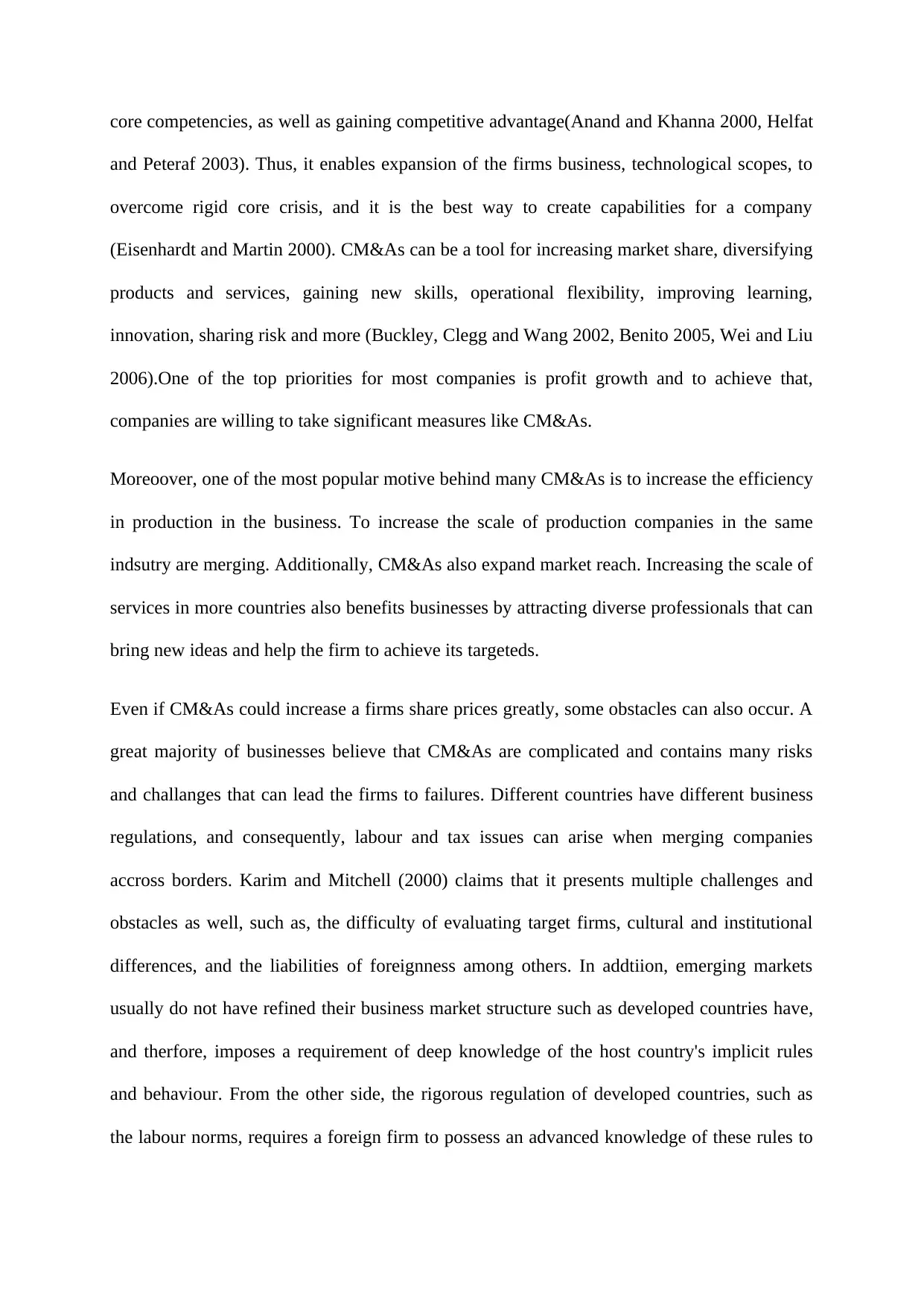
core competencies, as well as gaining competitive advantage(Anand and Khanna 2000, Helfat
and Peteraf 2003). Thus, it enables expansion of the firms business, technological scopes, to
overcome rigid core crisis, and it is the best way to create capabilities for a company
(Eisenhardt and Martin 2000). CM&As can be a tool for increasing market share, diversifying
products and services, gaining new skills, operational flexibility, improving learning,
innovation, sharing risk and more (Buckley, Clegg and Wang 2002, Benito 2005, Wei and Liu
2006).One of the top priorities for most companies is profit growth and to achieve that,
companies are willing to take significant measures like CM&As.
Moreoover, one of the most popular motive behind many CM&As is to increase the efficiency
in production in the business. To increase the scale of production companies in the same
indsutry are merging. Additionally, CM&As also expand market reach. Increasing the scale of
services in more countries also benefits businesses by attracting diverse professionals that can
bring new ideas and help the firm to achieve its targeteds.
Even if CM&As could increase a firms share prices greatly, some obstacles can also occur. A
great majority of businesses believe that CM&As are complicated and contains many risks
and challanges that can lead the firms to failures. Different countries have different business
regulations, and consequently, labour and tax issues can arise when merging companies
accross borders. Karim and Mitchell (2000) claims that it presents multiple challenges and
obstacles as well, such as, the difficulty of evaluating target firms, cultural and institutional
differences, and the liabilities of foreignness among others. In addtiion, emerging markets
usually do not have refined their business market structure such as developed countries have,
and therfore, imposes a requirement of deep knowledge of the host country's implicit rules
and behaviour. From the other side, the rigorous regulation of developed countries, such as
the labour norms, requires a foreign firm to possess an advanced knowledge of these rules to
and Peteraf 2003). Thus, it enables expansion of the firms business, technological scopes, to
overcome rigid core crisis, and it is the best way to create capabilities for a company
(Eisenhardt and Martin 2000). CM&As can be a tool for increasing market share, diversifying
products and services, gaining new skills, operational flexibility, improving learning,
innovation, sharing risk and more (Buckley, Clegg and Wang 2002, Benito 2005, Wei and Liu
2006).One of the top priorities for most companies is profit growth and to achieve that,
companies are willing to take significant measures like CM&As.
Moreoover, one of the most popular motive behind many CM&As is to increase the efficiency
in production in the business. To increase the scale of production companies in the same
indsutry are merging. Additionally, CM&As also expand market reach. Increasing the scale of
services in more countries also benefits businesses by attracting diverse professionals that can
bring new ideas and help the firm to achieve its targeteds.
Even if CM&As could increase a firms share prices greatly, some obstacles can also occur. A
great majority of businesses believe that CM&As are complicated and contains many risks
and challanges that can lead the firms to failures. Different countries have different business
regulations, and consequently, labour and tax issues can arise when merging companies
accross borders. Karim and Mitchell (2000) claims that it presents multiple challenges and
obstacles as well, such as, the difficulty of evaluating target firms, cultural and institutional
differences, and the liabilities of foreignness among others. In addtiion, emerging markets
usually do not have refined their business market structure such as developed countries have,
and therfore, imposes a requirement of deep knowledge of the host country's implicit rules
and behaviour. From the other side, the rigorous regulation of developed countries, such as
the labour norms, requires a foreign firm to possess an advanced knowledge of these rules to
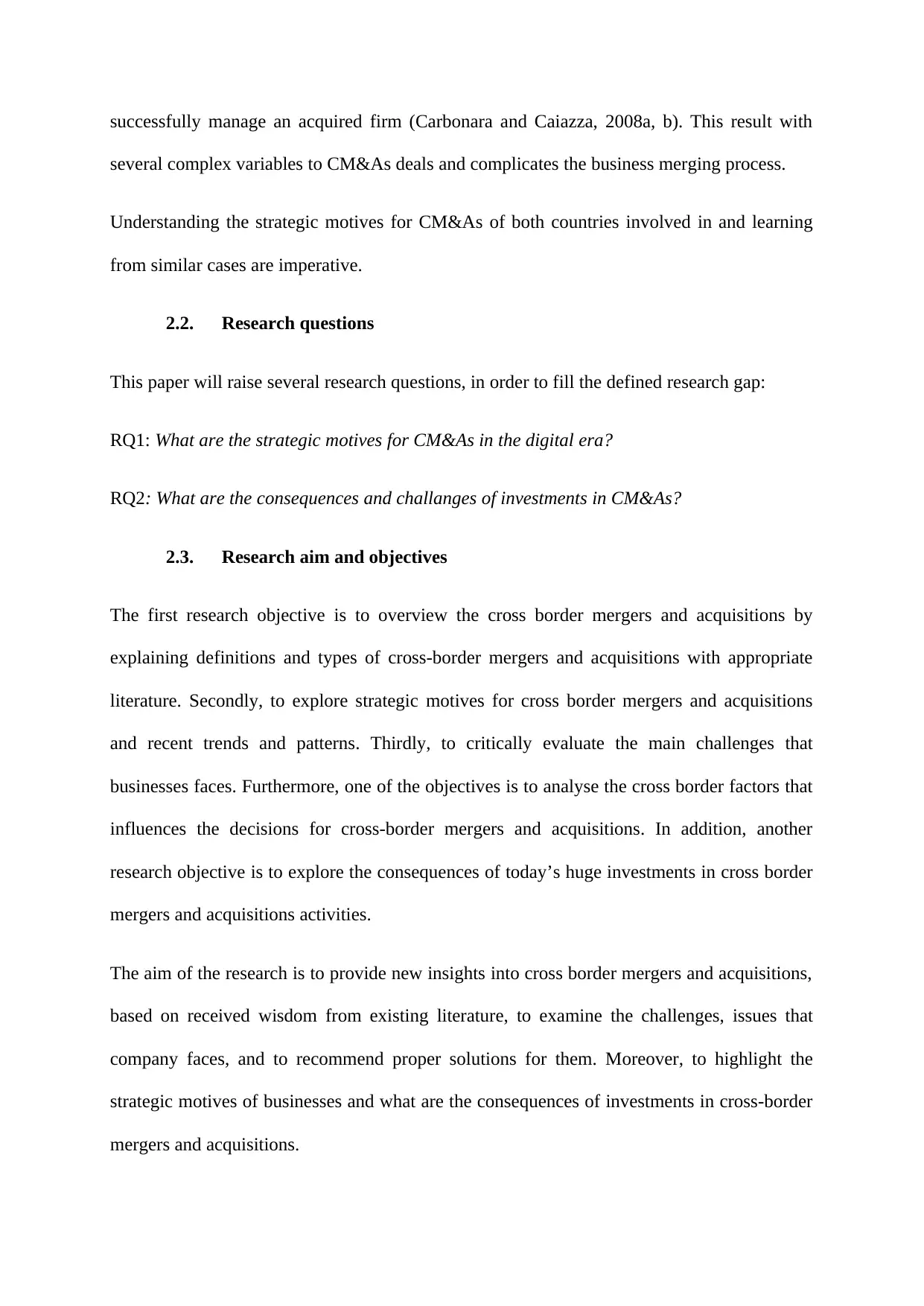
successfully manage an acquired firm (Carbonara and Caiazza, 2008a, b). This result with
several complex variables to CM&As deals and complicates the business merging process.
Understanding the strategic motives for CM&As of both countries involved in and learning
from similar cases are imperative.
2.2. Research questions
This paper will raise several research questions, in order to fill the defined research gap:
RQ1: What are the strategic motives for CM&As in the digital era?
RQ2: What are the consequences and challanges of investments in CM&As?
2.3. Research aim and objectives
The first research objective is to overview the cross border mergers and acquisitions by
explaining definitions and types of cross-border mergers and acquisitions with appropriate
literature. Secondly, to explore strategic motives for cross border mergers and acquisitions
and recent trends and patterns. Thirdly, to critically evaluate the main challenges that
businesses faces. Furthermore, one of the objectives is to analyse the cross border factors that
influences the decisions for cross-border mergers and acquisitions. In addition, another
research objective is to explore the consequences of today’s huge investments in cross border
mergers and acquisitions activities.
The aim of the research is to provide new insights into cross border mergers and acquisitions,
based on received wisdom from existing literature, to examine the challenges, issues that
company faces, and to recommend proper solutions for them. Moreover, to highlight the
strategic motives of businesses and what are the consequences of investments in cross-border
mergers and acquisitions.
several complex variables to CM&As deals and complicates the business merging process.
Understanding the strategic motives for CM&As of both countries involved in and learning
from similar cases are imperative.
2.2. Research questions
This paper will raise several research questions, in order to fill the defined research gap:
RQ1: What are the strategic motives for CM&As in the digital era?
RQ2: What are the consequences and challanges of investments in CM&As?
2.3. Research aim and objectives
The first research objective is to overview the cross border mergers and acquisitions by
explaining definitions and types of cross-border mergers and acquisitions with appropriate
literature. Secondly, to explore strategic motives for cross border mergers and acquisitions
and recent trends and patterns. Thirdly, to critically evaluate the main challenges that
businesses faces. Furthermore, one of the objectives is to analyse the cross border factors that
influences the decisions for cross-border mergers and acquisitions. In addition, another
research objective is to explore the consequences of today’s huge investments in cross border
mergers and acquisitions activities.
The aim of the research is to provide new insights into cross border mergers and acquisitions,
based on received wisdom from existing literature, to examine the challenges, issues that
company faces, and to recommend proper solutions for them. Moreover, to highlight the
strategic motives of businesses and what are the consequences of investments in cross-border
mergers and acquisitions.
⊘ This is a preview!⊘
Do you want full access?
Subscribe today to unlock all pages.

Trusted by 1+ million students worldwide
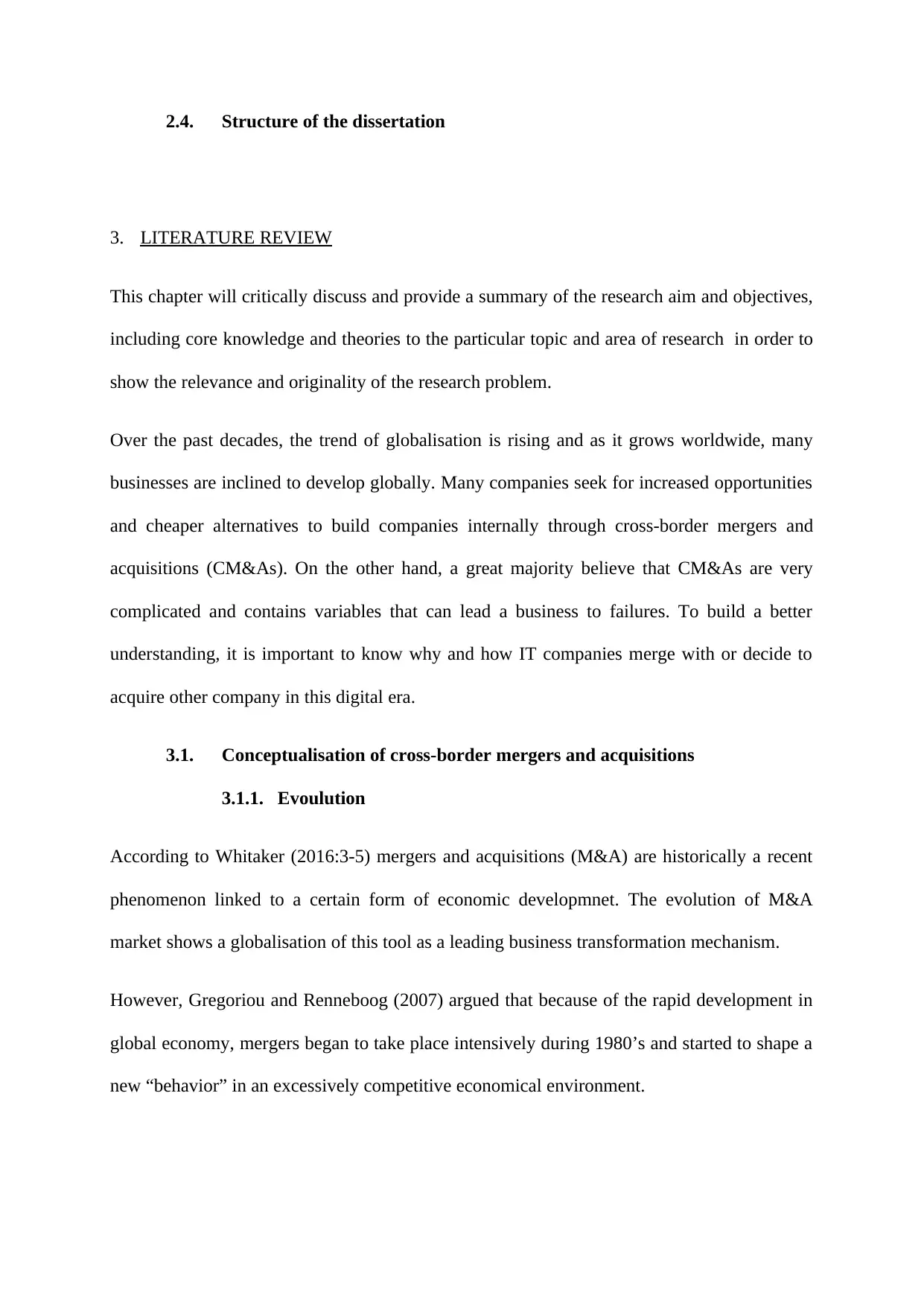
2.4. Structure of the dissertation
3. LITERATURE REVIEW
This chapter will critically discuss and provide a summary of the research aim and objectives,
including core knowledge and theories to the particular topic and area of research in order to
show the relevance and originality of the research problem.
Over the past decades, the trend of globalisation is rising and as it grows worldwide, many
businesses are inclined to develop globally. Many companies seek for increased opportunities
and cheaper alternatives to build companies internally through cross-border mergers and
acquisitions (CM&As). On the other hand, a great majority believe that CM&As are very
complicated and contains variables that can lead a business to failures. To build a better
understanding, it is important to know why and how IT companies merge with or decide to
acquire other company in this digital era.
3.1. Conceptualisation of cross-border mergers and acquisitions
3.1.1. Evoulution
According to Whitaker (2016:3-5) mergers and acquisitions (M&A) are historically a recent
phenomenon linked to a certain form of economic developmnet. The evolution of M&A
market shows a globalisation of this tool as a leading business transformation mechanism.
However, Gregoriou and Renneboog (2007) argued that because of the rapid development in
global economy, mergers began to take place intensively during 1980’s and started to shape a
new “behavior” in an excessively competitive economical environment.
3. LITERATURE REVIEW
This chapter will critically discuss and provide a summary of the research aim and objectives,
including core knowledge and theories to the particular topic and area of research in order to
show the relevance and originality of the research problem.
Over the past decades, the trend of globalisation is rising and as it grows worldwide, many
businesses are inclined to develop globally. Many companies seek for increased opportunities
and cheaper alternatives to build companies internally through cross-border mergers and
acquisitions (CM&As). On the other hand, a great majority believe that CM&As are very
complicated and contains variables that can lead a business to failures. To build a better
understanding, it is important to know why and how IT companies merge with or decide to
acquire other company in this digital era.
3.1. Conceptualisation of cross-border mergers and acquisitions
3.1.1. Evoulution
According to Whitaker (2016:3-5) mergers and acquisitions (M&A) are historically a recent
phenomenon linked to a certain form of economic developmnet. The evolution of M&A
market shows a globalisation of this tool as a leading business transformation mechanism.
However, Gregoriou and Renneboog (2007) argued that because of the rapid development in
global economy, mergers began to take place intensively during 1980’s and started to shape a
new “behavior” in an excessively competitive economical environment.
Paraphrase This Document
Need a fresh take? Get an instant paraphrase of this document with our AI Paraphraser
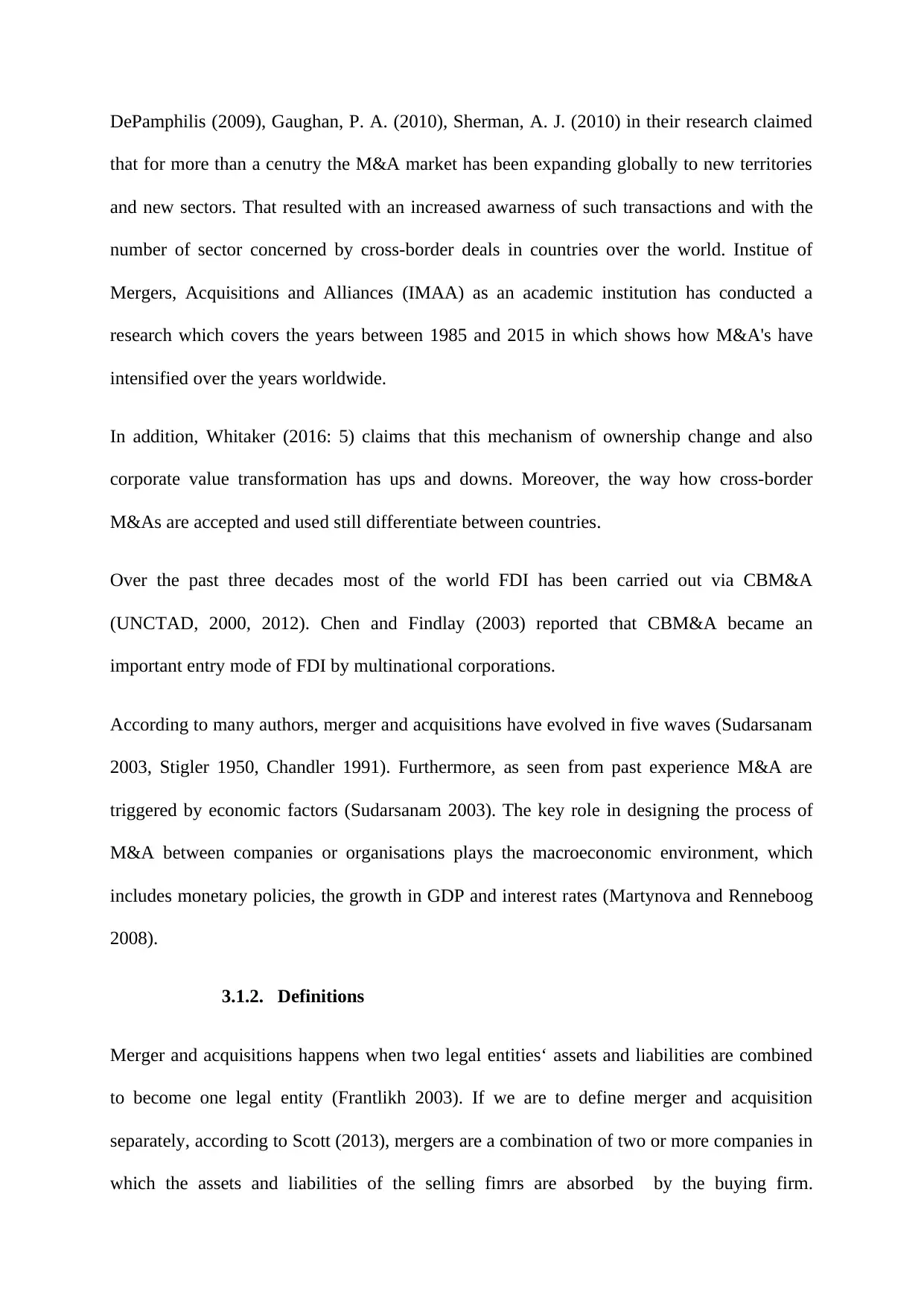
DePamphilis (2009), Gaughan, P. A. (2010), Sherman, A. J. (2010) in their research claimed
that for more than a cenutry the M&A market has been expanding globally to new territories
and new sectors. That resulted with an increased awarness of such transactions and with the
number of sector concerned by cross-border deals in countries over the world. Institue of
Mergers, Acquisitions and Alliances (IMAA) as an academic institution has conducted a
research which covers the years between 1985 and 2015 in which shows how M&A's have
intensified over the years worldwide.
In addition, Whitaker (2016: 5) claims that this mechanism of ownership change and also
corporate value transformation has ups and downs. Moreover, the way how cross-border
M&As are accepted and used still differentiate between countries.
Over the past three decades most of the world FDI has been carried out via CBM&A
(UNCTAD, 2000, 2012). Chen and Findlay (2003) reported that CBM&A became an
important entry mode of FDI by multinational corporations.
According to many authors, merger and acquisitions have evolved in five waves (Sudarsanam
2003, Stigler 1950, Chandler 1991). Furthermore, as seen from past experience M&A are
triggered by economic factors (Sudarsanam 2003). The key role in designing the process of
M&A between companies or organisations plays the macroeconomic environment, which
includes monetary policies, the growth in GDP and interest rates (Martynova and Renneboog
2008).
3.1.2. Definitions
Merger and acquisitions happens when two legal entities‘ assets and liabilities are combined
to become one legal entity (Frantlikh 2003). If we are to define merger and acquisition
separately, according to Scott (2013), mergers are a combination of two or more companies in
which the assets and liabilities of the selling fimrs are absorbed by the buying firm.
that for more than a cenutry the M&A market has been expanding globally to new territories
and new sectors. That resulted with an increased awarness of such transactions and with the
number of sector concerned by cross-border deals in countries over the world. Institue of
Mergers, Acquisitions and Alliances (IMAA) as an academic institution has conducted a
research which covers the years between 1985 and 2015 in which shows how M&A's have
intensified over the years worldwide.
In addition, Whitaker (2016: 5) claims that this mechanism of ownership change and also
corporate value transformation has ups and downs. Moreover, the way how cross-border
M&As are accepted and used still differentiate between countries.
Over the past three decades most of the world FDI has been carried out via CBM&A
(UNCTAD, 2000, 2012). Chen and Findlay (2003) reported that CBM&A became an
important entry mode of FDI by multinational corporations.
According to many authors, merger and acquisitions have evolved in five waves (Sudarsanam
2003, Stigler 1950, Chandler 1991). Furthermore, as seen from past experience M&A are
triggered by economic factors (Sudarsanam 2003). The key role in designing the process of
M&A between companies or organisations plays the macroeconomic environment, which
includes monetary policies, the growth in GDP and interest rates (Martynova and Renneboog
2008).
3.1.2. Definitions
Merger and acquisitions happens when two legal entities‘ assets and liabilities are combined
to become one legal entity (Frantlikh 2003). If we are to define merger and acquisition
separately, according to Scott (2013), mergers are a combination of two or more companies in
which the assets and liabilities of the selling fimrs are absorbed by the buying firm.
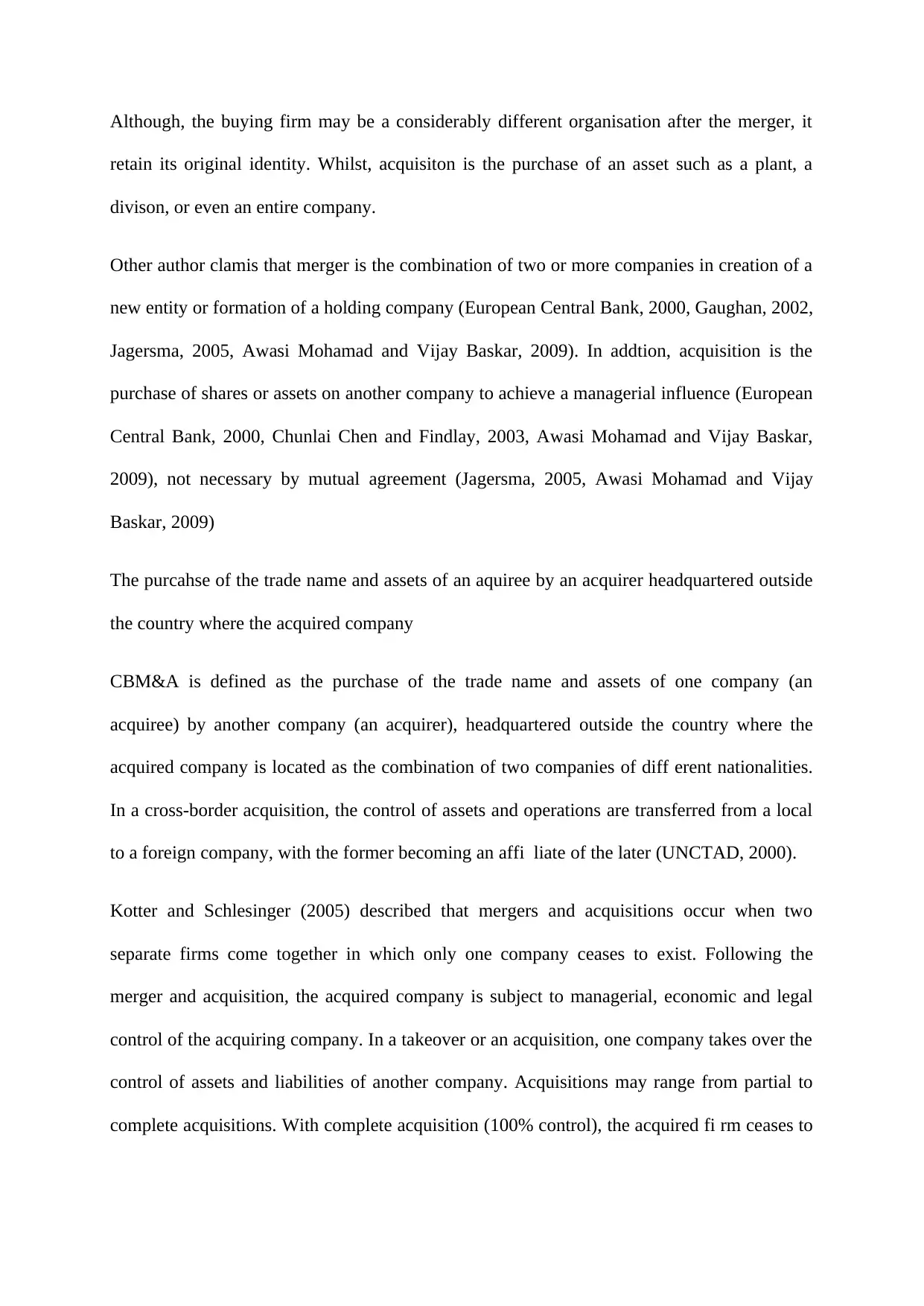
Although, the buying firm may be a considerably different organisation after the merger, it
retain its original identity. Whilst, acquisiton is the purchase of an asset such as a plant, a
divison, or even an entire company.
Other author clamis that merger is the combination of two or more companies in creation of a
new entity or formation of a holding company (European Central Bank, 2000, Gaughan, 2002,
Jagersma, 2005, Awasi Mohamad and Vijay Baskar, 2009). In addtion, acquisition is the
purchase of shares or assets on another company to achieve a managerial influence (European
Central Bank, 2000, Chunlai Chen and Findlay, 2003, Awasi Mohamad and Vijay Baskar,
2009), not necessary by mutual agreement (Jagersma, 2005, Awasi Mohamad and Vijay
Baskar, 2009)
The purcahse of the trade name and assets of an aquiree by an acquirer headquartered outside
the country where the acquired company
CBM&A is defined as the purchase of the trade name and assets of one company (an
acquiree) by another company (an acquirer), headquartered outside the country where the
acquired company is located as the combination of two companies of diff erent nationalities.
In a cross-border acquisition, the control of assets and operations are transferred from a local
to a foreign company, with the former becoming an affi liate of the later (UNCTAD, 2000).
Kotter and Schlesinger (2005) described that mergers and acquisitions occur when two
separate firms come together in which only one company ceases to exist. Following the
merger and acquisition, the acquired company is subject to managerial, economic and legal
control of the acquiring company. In a takeover or an acquisition, one company takes over the
control of assets and liabilities of another company. Acquisitions may range from partial to
complete acquisitions. With complete acquisition (100% control), the acquired fi rm ceases to
retain its original identity. Whilst, acquisiton is the purchase of an asset such as a plant, a
divison, or even an entire company.
Other author clamis that merger is the combination of two or more companies in creation of a
new entity or formation of a holding company (European Central Bank, 2000, Gaughan, 2002,
Jagersma, 2005, Awasi Mohamad and Vijay Baskar, 2009). In addtion, acquisition is the
purchase of shares or assets on another company to achieve a managerial influence (European
Central Bank, 2000, Chunlai Chen and Findlay, 2003, Awasi Mohamad and Vijay Baskar,
2009), not necessary by mutual agreement (Jagersma, 2005, Awasi Mohamad and Vijay
Baskar, 2009)
The purcahse of the trade name and assets of an aquiree by an acquirer headquartered outside
the country where the acquired company
CBM&A is defined as the purchase of the trade name and assets of one company (an
acquiree) by another company (an acquirer), headquartered outside the country where the
acquired company is located as the combination of two companies of diff erent nationalities.
In a cross-border acquisition, the control of assets and operations are transferred from a local
to a foreign company, with the former becoming an affi liate of the later (UNCTAD, 2000).
Kotter and Schlesinger (2005) described that mergers and acquisitions occur when two
separate firms come together in which only one company ceases to exist. Following the
merger and acquisition, the acquired company is subject to managerial, economic and legal
control of the acquiring company. In a takeover or an acquisition, one company takes over the
control of assets and liabilities of another company. Acquisitions may range from partial to
complete acquisitions. With complete acquisition (100% control), the acquired fi rm ceases to
⊘ This is a preview!⊘
Do you want full access?
Subscribe today to unlock all pages.

Trusted by 1+ million students worldwide
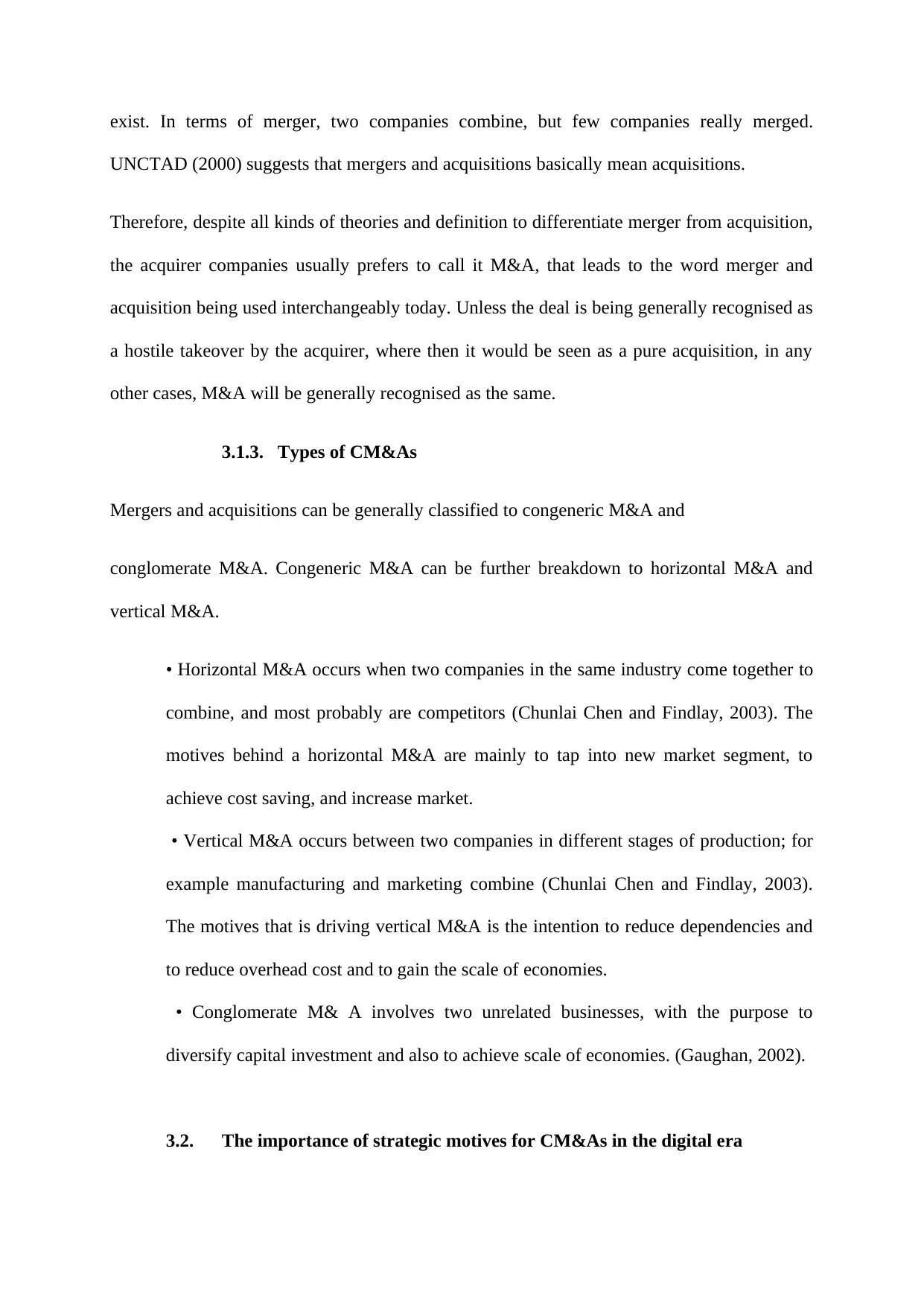
exist. In terms of merger, two companies combine, but few companies really merged.
UNCTAD (2000) suggests that mergers and acquisitions basically mean acquisitions.
Therefore, despite all kinds of theories and definition to differentiate merger from acquisition,
the acquirer companies usually prefers to call it M&A, that leads to the word merger and
acquisition being used interchangeably today. Unless the deal is being generally recognised as
a hostile takeover by the acquirer, where then it would be seen as a pure acquisition, in any
other cases, M&A will be generally recognised as the same.
3.1.3. Types of CM&As
Mergers and acquisitions can be generally classified to congeneric M&A and
conglomerate M&A. Congeneric M&A can be further breakdown to horizontal M&A and
vertical M&A.
• Horizontal M&A occurs when two companies in the same industry come together to
combine, and most probably are competitors (Chunlai Chen and Findlay, 2003). The
motives behind a horizontal M&A are mainly to tap into new market segment, to
achieve cost saving, and increase market.
• Vertical M&A occurs between two companies in different stages of production; for
example manufacturing and marketing combine (Chunlai Chen and Findlay, 2003).
The motives that is driving vertical M&A is the intention to reduce dependencies and
to reduce overhead cost and to gain the scale of economies.
• Conglomerate M& A involves two unrelated businesses, with the purpose to
diversify capital investment and also to achieve scale of economies. (Gaughan, 2002).
3.2. The importance of strategic motives for CM&As in the digital era
UNCTAD (2000) suggests that mergers and acquisitions basically mean acquisitions.
Therefore, despite all kinds of theories and definition to differentiate merger from acquisition,
the acquirer companies usually prefers to call it M&A, that leads to the word merger and
acquisition being used interchangeably today. Unless the deal is being generally recognised as
a hostile takeover by the acquirer, where then it would be seen as a pure acquisition, in any
other cases, M&A will be generally recognised as the same.
3.1.3. Types of CM&As
Mergers and acquisitions can be generally classified to congeneric M&A and
conglomerate M&A. Congeneric M&A can be further breakdown to horizontal M&A and
vertical M&A.
• Horizontal M&A occurs when two companies in the same industry come together to
combine, and most probably are competitors (Chunlai Chen and Findlay, 2003). The
motives behind a horizontal M&A are mainly to tap into new market segment, to
achieve cost saving, and increase market.
• Vertical M&A occurs between two companies in different stages of production; for
example manufacturing and marketing combine (Chunlai Chen and Findlay, 2003).
The motives that is driving vertical M&A is the intention to reduce dependencies and
to reduce overhead cost and to gain the scale of economies.
• Conglomerate M& A involves two unrelated businesses, with the purpose to
diversify capital investment and also to achieve scale of economies. (Gaughan, 2002).
3.2. The importance of strategic motives for CM&As in the digital era
Paraphrase This Document
Need a fresh take? Get an instant paraphrase of this document with our AI Paraphraser
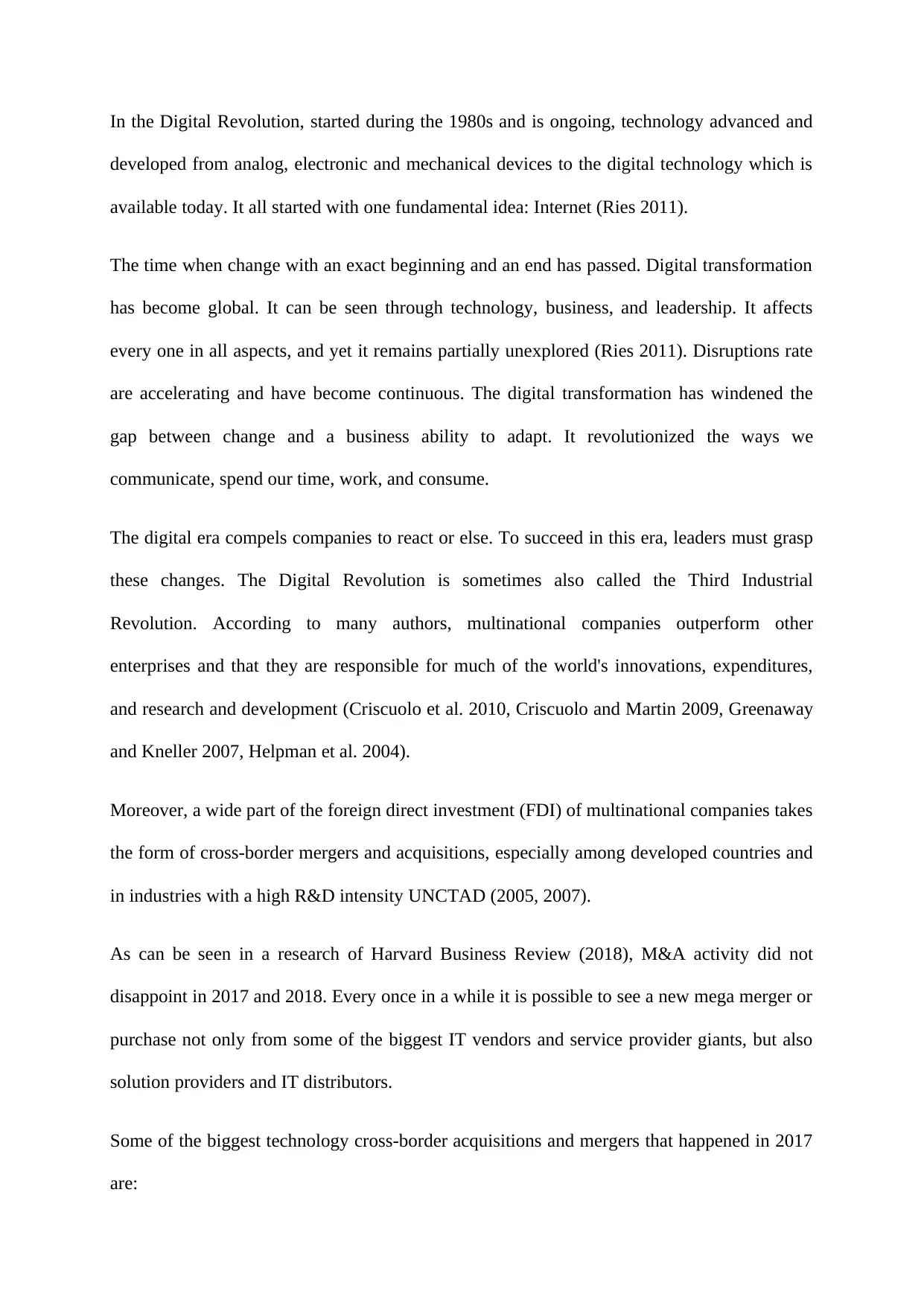
In the Digital Revolution, started during the 1980s and is ongoing, technology advanced and
developed from analog, electronic and mechanical devices to the digital technology which is
available today. It all started with one fundamental idea: Internet (Ries 2011).
The time when change with an exact beginning and an end has passed. Digital transformation
has become global. It can be seen through technology, business, and leadership. It affects
every one in all aspects, and yet it remains partially unexplored (Ries 2011). Disruptions rate
are accelerating and have become continuous. The digital transformation has windened the
gap between change and a business ability to adapt. It revolutionized the ways we
communicate, spend our time, work, and consume.
The digital era compels companies to react or else. To succeed in this era, leaders must grasp
these changes. The Digital Revolution is sometimes also called the Third Industrial
Revolution. According to many authors, multinational companies outperform other
enterprises and that they are responsible for much of the world's innovations, expenditures,
and research and development (Criscuolo et al. 2010, Criscuolo and Martin 2009, Greenaway
and Kneller 2007, Helpman et al. 2004).
Moreover, a wide part of the foreign direct investment (FDI) of multinational companies takes
the form of cross-border mergers and acquisitions, especially among developed countries and
in industries with a high R&D intensity UNCTAD (2005, 2007).
As can be seen in a research of Harvard Business Review (2018), M&A activity did not
disappoint in 2017 and 2018. Every once in a while it is possible to see a new mega merger or
purchase not only from some of the biggest IT vendors and service provider giants, but also
solution providers and IT distributors.
Some of the biggest technology cross-border acquisitions and mergers that happened in 2017
are:
developed from analog, electronic and mechanical devices to the digital technology which is
available today. It all started with one fundamental idea: Internet (Ries 2011).
The time when change with an exact beginning and an end has passed. Digital transformation
has become global. It can be seen through technology, business, and leadership. It affects
every one in all aspects, and yet it remains partially unexplored (Ries 2011). Disruptions rate
are accelerating and have become continuous. The digital transformation has windened the
gap between change and a business ability to adapt. It revolutionized the ways we
communicate, spend our time, work, and consume.
The digital era compels companies to react or else. To succeed in this era, leaders must grasp
these changes. The Digital Revolution is sometimes also called the Third Industrial
Revolution. According to many authors, multinational companies outperform other
enterprises and that they are responsible for much of the world's innovations, expenditures,
and research and development (Criscuolo et al. 2010, Criscuolo and Martin 2009, Greenaway
and Kneller 2007, Helpman et al. 2004).
Moreover, a wide part of the foreign direct investment (FDI) of multinational companies takes
the form of cross-border mergers and acquisitions, especially among developed countries and
in industries with a high R&D intensity UNCTAD (2005, 2007).
As can be seen in a research of Harvard Business Review (2018), M&A activity did not
disappoint in 2017 and 2018. Every once in a while it is possible to see a new mega merger or
purchase not only from some of the biggest IT vendors and service provider giants, but also
solution providers and IT distributors.
Some of the biggest technology cross-border acquisitions and mergers that happened in 2017
are:
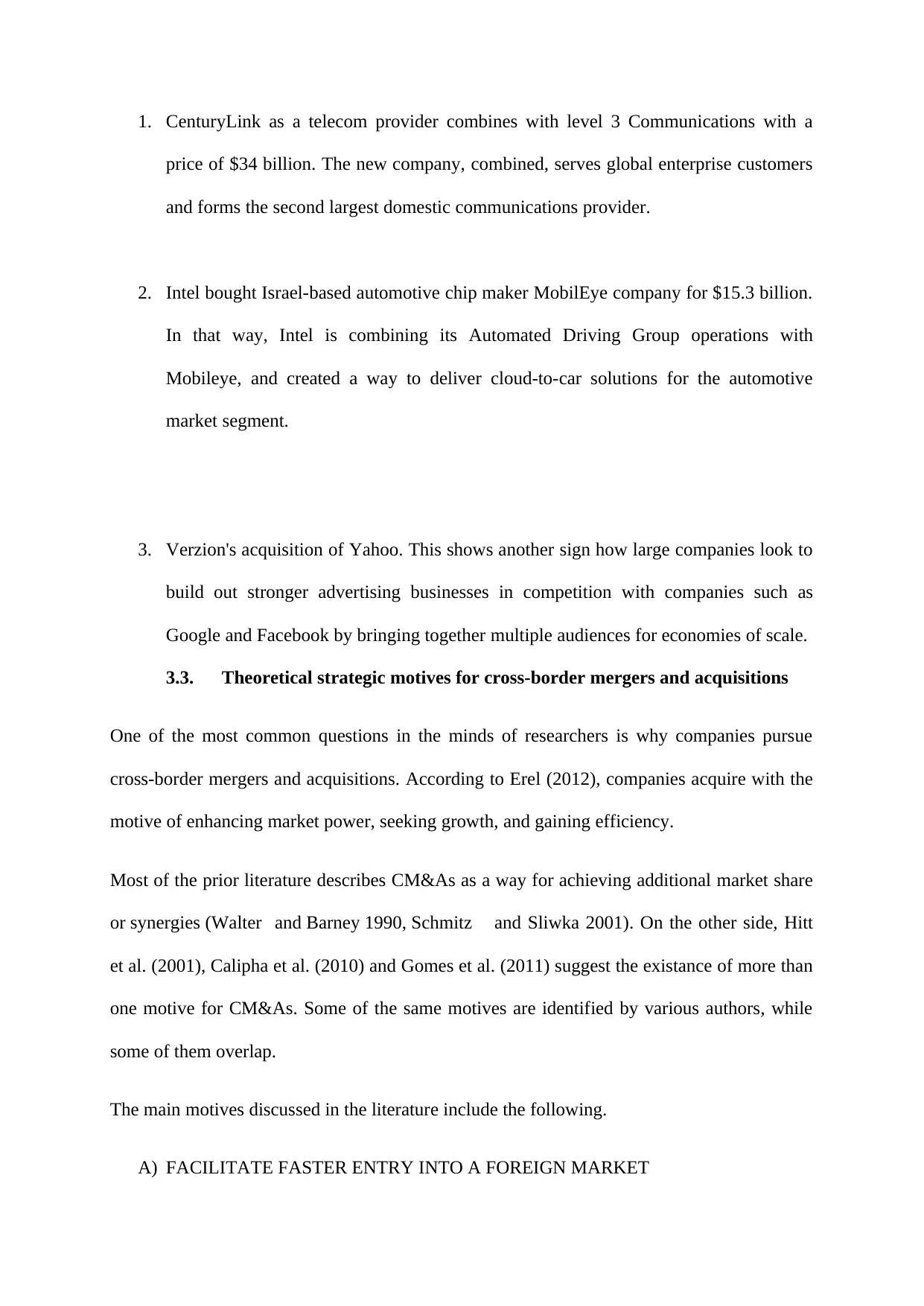
1. CenturyLink as a telecom provider combines with level 3 Communications with a
price of $34 billion. The new company, combined, serves global enterprise customers
and forms the second largest domestic communications provider.
2. Intel bought Israel-based automotive chip maker MobilEye company for $15.3 billion.
In that way, Intel is combining its Automated Driving Group operations with
Mobileye, and created a way to deliver cloud-to-car solutions for the automotive
market segment.
3. Verzion's acquisition of Yahoo. This shows another sign how large companies look to
build out stronger advertising businesses in competition with companies such as
Google and Facebook by bringing together multiple audiences for economies of scale.
3.3. Theoretical strategic motives for cross-border mergers and acquisitions
One of the most common questions in the minds of researchers is why companies pursue
cross-border mergers and acquisitions. According to Erel (2012), companies acquire with the
motive of enhancing market power, seeking growth, and gaining efficiency.
Most of the prior literature describes CM&As as a way for achieving additional market share
or synergies (Walter and Barney 1990, Schmitz and Sliwka 2001). On the other side, Hitt
et al. (2001), Calipha et al. (2010) and Gomes et al. (2011) suggest the existance of more than
one motive for CM&As. Some of the same motives are identified by various authors, while
some of them overlap.
The main motives discussed in the literature include the following.
A) FACILITATE FASTER ENTRY INTO A FOREIGN MARKET
price of $34 billion. The new company, combined, serves global enterprise customers
and forms the second largest domestic communications provider.
2. Intel bought Israel-based automotive chip maker MobilEye company for $15.3 billion.
In that way, Intel is combining its Automated Driving Group operations with
Mobileye, and created a way to deliver cloud-to-car solutions for the automotive
market segment.
3. Verzion's acquisition of Yahoo. This shows another sign how large companies look to
build out stronger advertising businesses in competition with companies such as
Google and Facebook by bringing together multiple audiences for economies of scale.
3.3. Theoretical strategic motives for cross-border mergers and acquisitions
One of the most common questions in the minds of researchers is why companies pursue
cross-border mergers and acquisitions. According to Erel (2012), companies acquire with the
motive of enhancing market power, seeking growth, and gaining efficiency.
Most of the prior literature describes CM&As as a way for achieving additional market share
or synergies (Walter and Barney 1990, Schmitz and Sliwka 2001). On the other side, Hitt
et al. (2001), Calipha et al. (2010) and Gomes et al. (2011) suggest the existance of more than
one motive for CM&As. Some of the same motives are identified by various authors, while
some of them overlap.
The main motives discussed in the literature include the following.
A) FACILITATE FASTER ENTRY INTO A FOREIGN MARKET
⊘ This is a preview!⊘
Do you want full access?
Subscribe today to unlock all pages.

Trusted by 1+ million students worldwide
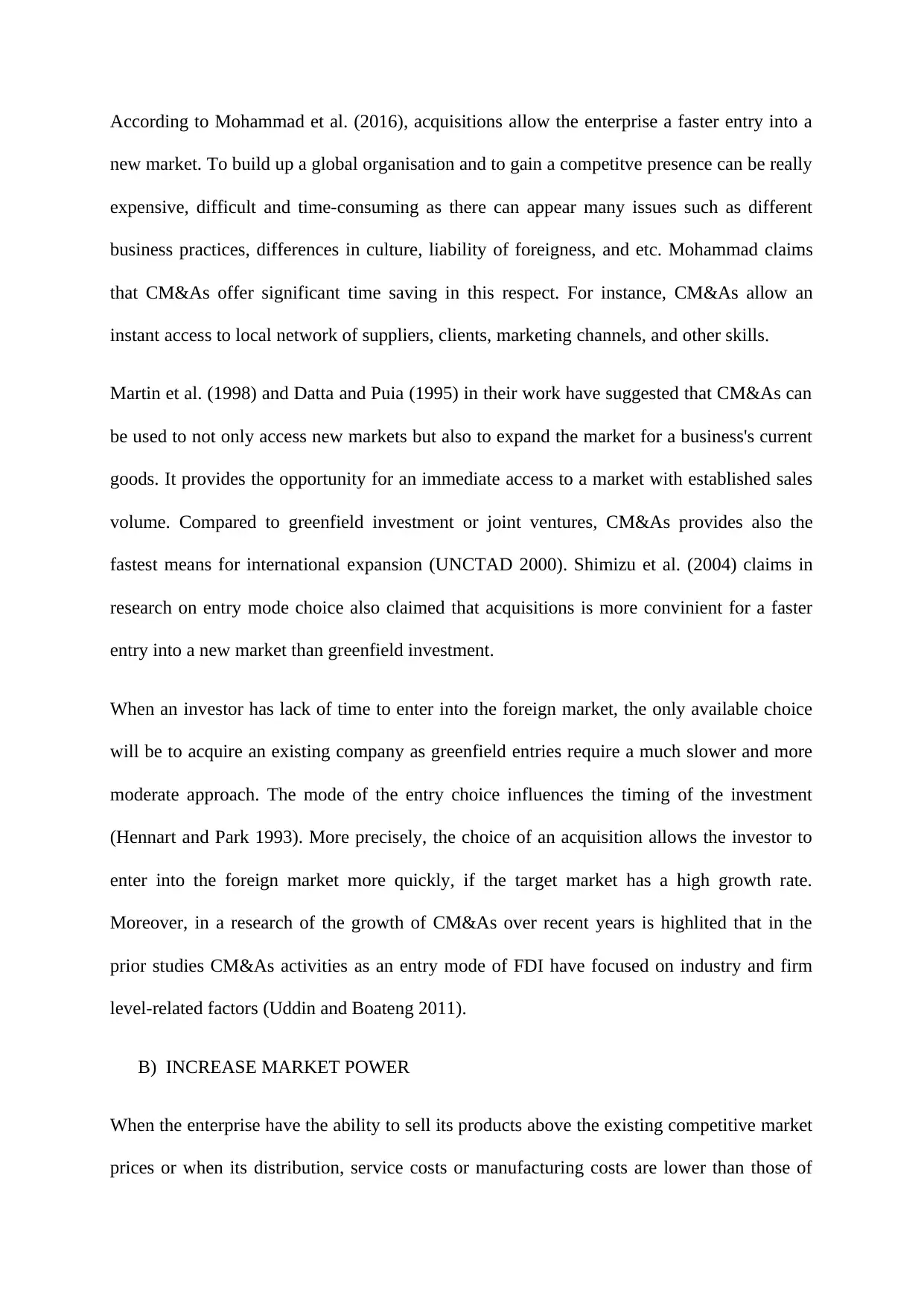
According to Mohammad et al. (2016), acquisitions allow the enterprise a faster entry into a
new market. To build up a global organisation and to gain a competitve presence can be really
expensive, difficult and time-consuming as there can appear many issues such as different
business practices, differences in culture, liability of foreigness, and etc. Mohammad claims
that CM&As offer significant time saving in this respect. For instance, CM&As allow an
instant access to local network of suppliers, clients, marketing channels, and other skills.
Martin et al. (1998) and Datta and Puia (1995) in their work have suggested that CM&As can
be used to not only access new markets but also to expand the market for a business's current
goods. It provides the opportunity for an immediate access to a market with established sales
volume. Compared to greenfield investment or joint ventures, CM&As provides also the
fastest means for international expansion (UNCTAD 2000). Shimizu et al. (2004) claims in
research on entry mode choice also claimed that acquisitions is more convinient for a faster
entry into a new market than greenfield investment.
When an investor has lack of time to enter into the foreign market, the only available choice
will be to acquire an existing company as greenfield entries require a much slower and more
moderate approach. The mode of the entry choice influences the timing of the investment
(Hennart and Park 1993). More precisely, the choice of an acquisition allows the investor to
enter into the foreign market more quickly, if the target market has a high growth rate.
Moreover, in a research of the growth of CM&As over recent years is highlited that in the
prior studies CM&As activities as an entry mode of FDI have focused on industry and firm
level-related factors (Uddin and Boateng 2011).
B) INCREASE MARKET POWER
When the enterprise have the ability to sell its products above the existing competitive market
prices or when its distribution, service costs or manufacturing costs are lower than those of
new market. To build up a global organisation and to gain a competitve presence can be really
expensive, difficult and time-consuming as there can appear many issues such as different
business practices, differences in culture, liability of foreigness, and etc. Mohammad claims
that CM&As offer significant time saving in this respect. For instance, CM&As allow an
instant access to local network of suppliers, clients, marketing channels, and other skills.
Martin et al. (1998) and Datta and Puia (1995) in their work have suggested that CM&As can
be used to not only access new markets but also to expand the market for a business's current
goods. It provides the opportunity for an immediate access to a market with established sales
volume. Compared to greenfield investment or joint ventures, CM&As provides also the
fastest means for international expansion (UNCTAD 2000). Shimizu et al. (2004) claims in
research on entry mode choice also claimed that acquisitions is more convinient for a faster
entry into a new market than greenfield investment.
When an investor has lack of time to enter into the foreign market, the only available choice
will be to acquire an existing company as greenfield entries require a much slower and more
moderate approach. The mode of the entry choice influences the timing of the investment
(Hennart and Park 1993). More precisely, the choice of an acquisition allows the investor to
enter into the foreign market more quickly, if the target market has a high growth rate.
Moreover, in a research of the growth of CM&As over recent years is highlited that in the
prior studies CM&As activities as an entry mode of FDI have focused on industry and firm
level-related factors (Uddin and Boateng 2011).
B) INCREASE MARKET POWER
When the enterprise have the ability to sell its products above the existing competitive market
prices or when its distribution, service costs or manufacturing costs are lower than those of
Paraphrase This Document
Need a fresh take? Get an instant paraphrase of this document with our AI Paraphraser
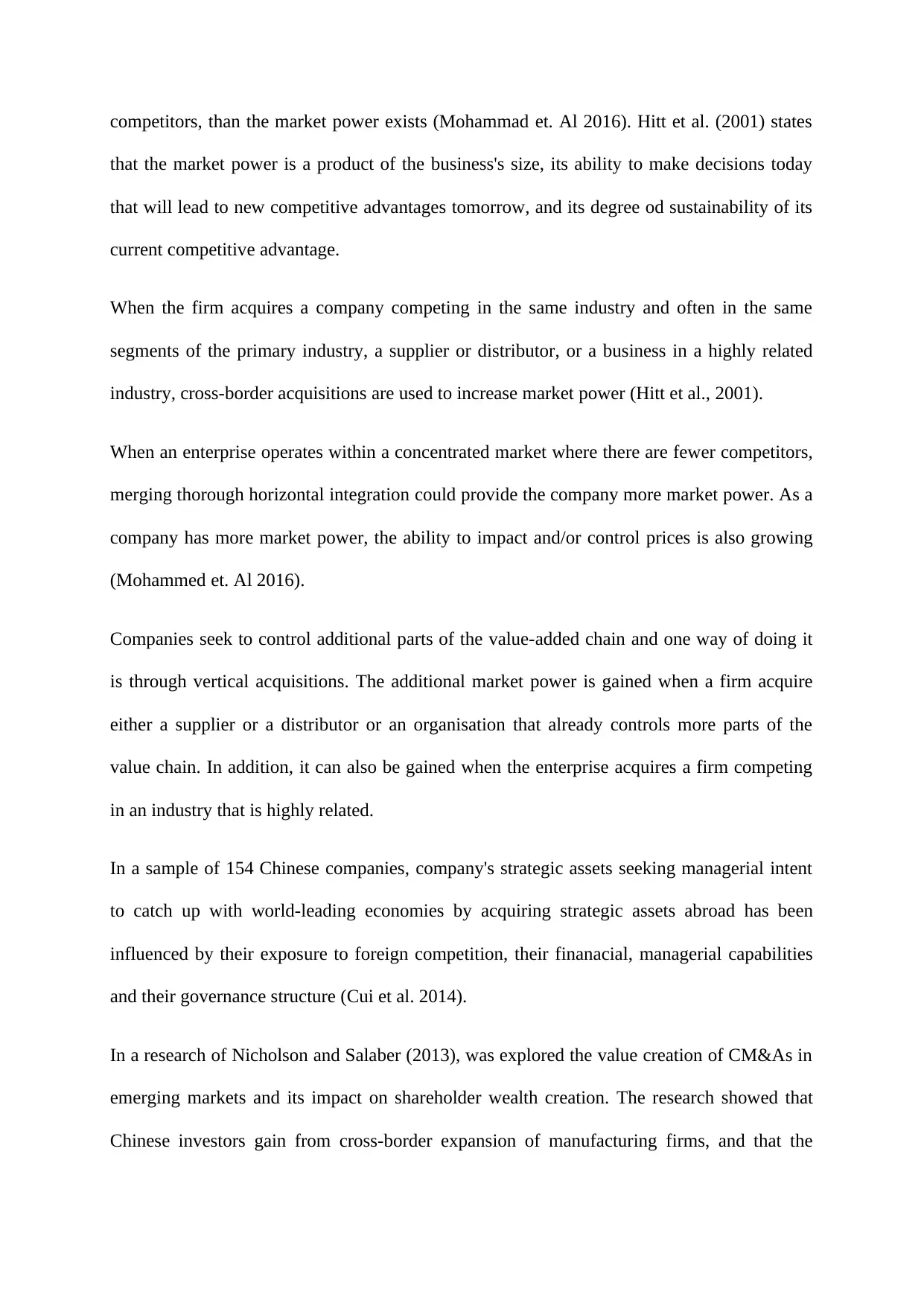
competitors, than the market power exists (Mohammad et. Al 2016). Hitt et al. (2001) states
that the market power is a product of the business's size, its ability to make decisions today
that will lead to new competitive advantages tomorrow, and its degree od sustainability of its
current competitive advantage.
When the firm acquires a company competing in the same industry and often in the same
segments of the primary industry, a supplier or distributor, or a business in a highly related
industry, cross-border acquisitions are used to increase market power (Hitt et al., 2001).
When an enterprise operates within a concentrated market where there are fewer competitors,
merging thorough horizontal integration could provide the company more market power. As a
company has more market power, the ability to impact and/or control prices is also growing
(Mohammed et. Al 2016).
Companies seek to control additional parts of the value-added chain and one way of doing it
is through vertical acquisitions. The additional market power is gained when a firm acquire
either a supplier or a distributor or an organisation that already controls more parts of the
value chain. In addition, it can also be gained when the enterprise acquires a firm competing
in an industry that is highly related.
In a sample of 154 Chinese companies, company's strategic assets seeking managerial intent
to catch up with world-leading economies by acquiring strategic assets abroad has been
influenced by their exposure to foreign competition, their finanacial, managerial capabilities
and their governance structure (Cui et al. 2014).
In a research of Nicholson and Salaber (2013), was explored the value creation of CM&As in
emerging markets and its impact on shareholder wealth creation. The research showed that
Chinese investors gain from cross-border expansion of manufacturing firms, and that the
that the market power is a product of the business's size, its ability to make decisions today
that will lead to new competitive advantages tomorrow, and its degree od sustainability of its
current competitive advantage.
When the firm acquires a company competing in the same industry and often in the same
segments of the primary industry, a supplier or distributor, or a business in a highly related
industry, cross-border acquisitions are used to increase market power (Hitt et al., 2001).
When an enterprise operates within a concentrated market where there are fewer competitors,
merging thorough horizontal integration could provide the company more market power. As a
company has more market power, the ability to impact and/or control prices is also growing
(Mohammed et. Al 2016).
Companies seek to control additional parts of the value-added chain and one way of doing it
is through vertical acquisitions. The additional market power is gained when a firm acquire
either a supplier or a distributor or an organisation that already controls more parts of the
value chain. In addition, it can also be gained when the enterprise acquires a firm competing
in an industry that is highly related.
In a sample of 154 Chinese companies, company's strategic assets seeking managerial intent
to catch up with world-leading economies by acquiring strategic assets abroad has been
influenced by their exposure to foreign competition, their finanacial, managerial capabilities
and their governance structure (Cui et al. 2014).
In a research of Nicholson and Salaber (2013), was explored the value creation of CM&As in
emerging markets and its impact on shareholder wealth creation. The research showed that
Chinese investors gain from cross-border expansion of manufacturing firms, and that the

performance of cross-border acquisitions can be also affected by the location, with
acqusisitons into developed countries generating higher returns for shareholders.
C) ACCESS TO AND ACQUISITON OF NEW RESOURCES AND TECHNOLOGY
A number of studies suggest that cross-border M&As are motivated by an opportunity to
acquire new capabilities and learn new knowledge (Barkema and Vermeulen 1998,
Madhok 1997,Vermeulen and Barkema 2001).
In this digital era, products rely on so many different critical technologies that most
enterprises can no longer maintain cutting-edge sophistication in all of them (Ohmae 1989).
Likewise, Shimzu et al. (2004) suggested that companies may engage in CM&As to exploit
intangible assets Correspondingly to Caves (1990) who agrues that acquisition of a foreign
competitor enables the acquirer to get more opportunities by bringing under its control a more
diverse stock of specific assets.
However, Buckley et al. (2014) indicated that while some types of resources and investment
experience might be beneficial, some other types of experience may have a damaging impact
on the performance of the incumbent target companies due to facilitating resource
redeployment and the exploitation of complementarities.
Additionally, cross-border acquisitions involving both an acquiring company and a target
company in the technology intensive sector provide opportunities for the acquiring company
to combine and judiciously utilise intangible resources of both companies on a broader scale
across new geographies and as a result create superior wealth gains (Kohli and Mann).
In an empirical study of companies between 2000 and 2009, Almor et al. (2014) found out
that bornglobal technology-based companies can increase their chances of survival by
acquiring other firms. However, Mohammad et. Al () claims that such acquisitions do not
acqusisitons into developed countries generating higher returns for shareholders.
C) ACCESS TO AND ACQUISITON OF NEW RESOURCES AND TECHNOLOGY
A number of studies suggest that cross-border M&As are motivated by an opportunity to
acquire new capabilities and learn new knowledge (Barkema and Vermeulen 1998,
Madhok 1997,Vermeulen and Barkema 2001).
In this digital era, products rely on so many different critical technologies that most
enterprises can no longer maintain cutting-edge sophistication in all of them (Ohmae 1989).
Likewise, Shimzu et al. (2004) suggested that companies may engage in CM&As to exploit
intangible assets Correspondingly to Caves (1990) who agrues that acquisition of a foreign
competitor enables the acquirer to get more opportunities by bringing under its control a more
diverse stock of specific assets.
However, Buckley et al. (2014) indicated that while some types of resources and investment
experience might be beneficial, some other types of experience may have a damaging impact
on the performance of the incumbent target companies due to facilitating resource
redeployment and the exploitation of complementarities.
Additionally, cross-border acquisitions involving both an acquiring company and a target
company in the technology intensive sector provide opportunities for the acquiring company
to combine and judiciously utilise intangible resources of both companies on a broader scale
across new geographies and as a result create superior wealth gains (Kohli and Mann).
In an empirical study of companies between 2000 and 2009, Almor et al. (2014) found out
that bornglobal technology-based companies can increase their chances of survival by
acquiring other firms. However, Mohammad et. Al () claims that such acquisitions do not
⊘ This is a preview!⊘
Do you want full access?
Subscribe today to unlock all pages.

Trusted by 1+ million students worldwide
1 out of 42
Related Documents
Your All-in-One AI-Powered Toolkit for Academic Success.
+13062052269
info@desklib.com
Available 24*7 on WhatsApp / Email
![[object Object]](/_next/static/media/star-bottom.7253800d.svg)
Unlock your academic potential
Copyright © 2020–2026 A2Z Services. All Rights Reserved. Developed and managed by ZUCOL.





